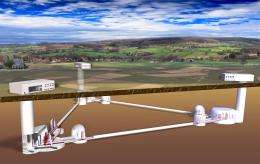CERN's new Einstein Observatory to explore black holes, Big Bang

A new era in astronomy will come a step closer when scientists from across Europe present their design study today for an advanced observatory capable of making precision measurements of gravitational waves -- minute ripples in the fabric of space-time -- predicted to emanate from cosmic catastrophes such as merging black holes and collapsing stars and supernovae. It also offers the potential to probe the earliest moments of the Universe just after the Big Bang, which are currently inaccessible.
The Einstein Observatory (ET) is a so-called third-generation gravitational-wave (GW) detector, which will be 100 times more sensitive than current instruments. Like the first two generations of GW detectors, it is based on the measurement of tiny changes (far less than the size of an atomic nucleus) in the lengths of two connected arms several kilometers long, caused by a passing gravity wave. Laser beams passing down the arms record their periodic stretching and shrinking as interference patterns in a central photo-detector.
The first generation of these interferometric detectors built a few years ago (GEO600, LIGO, Virgo and TAMA) successfully demonstrated the proof-of-principle and constrained the gravitational wave emission from several sources. The next generation (Advanced LIGO and Advanced Virgo), which are being constructed now, should make the first direct detection of gravitational waves -- for example, from a pair of orbiting black holes or neutron stars spiraling into each other. Such a discovery would herald the new field of GW astronomy. However, these detectors will not be sensitive enough for precise astronomical studies of the GW sources.
"The community of scientists interested in exploring GW phenomena therefore decided to investigate building a new generation of even more sensitive observatories. After a three-year study, involving more than 200 scientists in Europe and across the world, we are pleased to present the design study for the Einstein Telescope, which paves the way for unveiling a hidden side of the Universe," says Harald Lück, deputy scientific coordinator of the ET Design Study.
The design study, which will be presented at the European Gravitational Observatory site in Pisa, Italy, outlines ET's scientific targets, the detector layout and technology, as well as the timescale and estimated costs. I A superb sensitivity will be achieved by building ET underground, at a depth of about 100 to 200 meters, to reduce the effect of the residual seismic motion. This will enable higher sensitivities to be achieved at low frequencies, between 1 and 100 hertz (Hz). With ET, the entire range of GW frequencies that can be measured on Earth -- between about 1 Hz and 10 kHz -- should be detected. "An observatory achieving that level of sensitivity will turn GW detection into a routine astronomical tool. ET will lead a scientific revolution", says Michele Punturo, the scientific coordinator of the design study. An important aim is to provide GW information that complements observational data from telescopes detecting electromagnetic radiation (from radio waves through to gamma-rays) and other instruments detecting high-energy particles from space (astroparticle physics).
A Multi-Detector
The strategy behind the ET project is to build an observatory that overcomes the limitations of current detector sites by hosting more than one GW detector. It will consist of three nested detectors, each composed of two interferometers with arms 10 kilometers long. One
interferometer will detect low-frequency gravitational wave signals (2 to 40 Hz), while the other will detect the high-frequency components. The configuration is designed to allow the observatory to evolve by accommodating successive upgrades or replacement components that can take advantage of future developments in interferometry and also respond to a variety of science objectives.
Provided by CERN
















